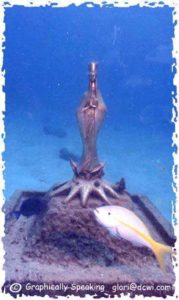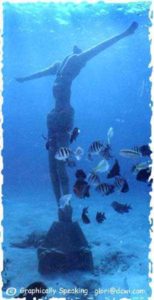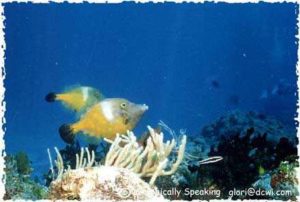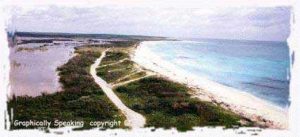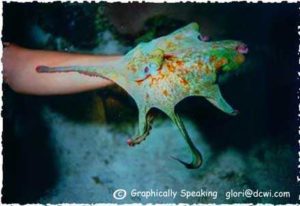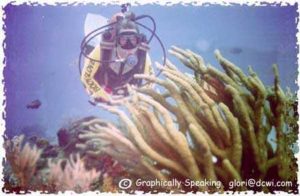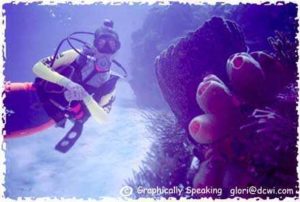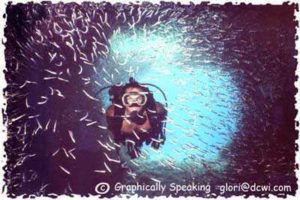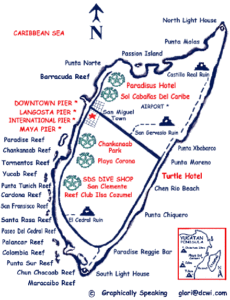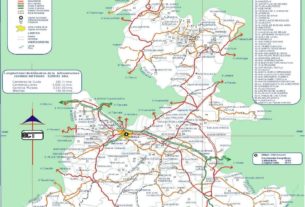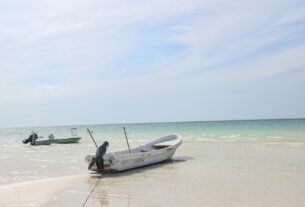Vistas de Cozumel
Until 1961, Cozumel was a sleepy little fishing village. Then, a television documentary by noted diver and nature lover, Jacques-Ives Cousteau, showed the world the beauty of our island waters. Today the very mention of Cozumel stirs images of tropical fish, aqua blue waters, and white powdery beaches. Even though hotels, restaurants, and other business have sprung up to serve tourists, when you visit Cozumel you’ll still feel as if you’re light years away from the rest of the world.
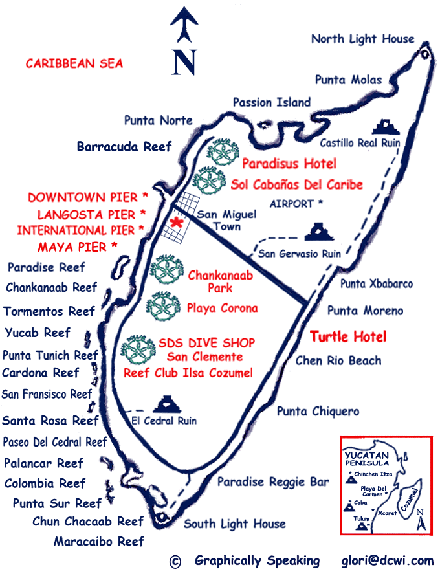
It’s a good bet that it was Cozumel’s natural beauty which attracted the Maya centuries ago. This great culture of warriors ruled from Campeche to Guatemala 2,000 years before the arrival of the Spanish explorers. They inhabited Cozumel from 300 A.D. to 1500 A.D. and remains of the Maya civilization are evident at San Gervacio (pronounced san-her-ba-see-oh). This was probably a capital city during ancient times. Today, it’s the island’s largest existing archaeological site. Covering an area of about 10 acres and situated in a beautiful, cool forest, this park and restoration project give us glimpses into the ancient Maya civilization. Guides cost from $12 to $20 for a group, or you can tour the area on your own.
Although San Gervacio is one of the lesser-known Maya sites, legend has it that this was once a sacred place where women journeyed to worship Ixchel, the goddess of love and fertility. Religious temples were dedicated in her honor and in return she sent her favorite bird as a sign of gratitude. For this reason, the Maya named the island Cuzamil-Pectin or “The Land of the Swallows.”
Cozumel is the largest inhabited island in the Mexican Republic and the oldest in the Caribbean group. Nestled just 12 miles off the eastern coast of the Yucatan Peninsula, it’s surface is approximately 80 percent jungle. The rest of the area constitutes San Miguel, a town of about 50,000 inhabitants. The island of Cozumel is actually a limestone plateau, measuring only 34 miles from north to south; nine miles east to west. BUT, don’t let land size fool you. Flat and lacking significant rivers or hills, Cozumel harbors an underground network of fresh water rivers which honeycomb the porous limestone, forming ” cenotes” or sink holes. These provide some of the most beautiful cave and cavern diving in the world. Many of these caves are highly decorated and when you enter them, you feel like you’re floating through the finest dry cave you have ever seen. These underwater environments are unique, each with its own particular marine/cave life.
The subtropical climate, with temperatures ranging from 70-85 degrees F, creates a perfect environment for all kinds of sea life, and Cozumel is famous for having the second largest reef in the world. Spectacular reefs, not wimpy ones, surround the island. There are 26 classes of corals identified in Cozumel, surpassing the 22 reported for the northeastern coast of the Yucatan. You don’t have to be a diver to enjoy this underwater scenery. Because of the clarity of the water (100 to 200 feet visibility), you can simply put on a mask and snorkel, jump in, and you’ll feel as if you’ve been dropped into a tropical fish tank!
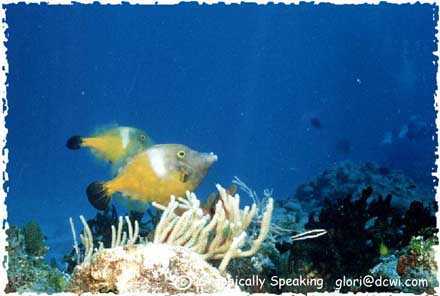
As a result of efforts by local activists, most of the reefs are now within a marine refuge. In 1996, The National Marine Park of Cozumel Reefs was created. This covers most of the reef system from north to south, along the east side of Cozumel. The area consists of 11,987.5 hectares, a great part of which includes humid soils, estuaries, mangroves, and rocky and sandy beaches which support important biological communities. Migratory and resident birds live here. In the National Marine Park, you’ll find mountain coral, soft coral, brain coral, star coral, finger coral, leaf coral, elkhorn coral, stag horn coral and gorgonians. It is also home to tube worms, feathered annelida, anemonae, crabs, reef shrimp, mollusks, echinoderms and sponges, plus 500 fish species.
You are prohibited from taking, breaking, or damaging any underwater organisms. Recently, the Cozumel dive operators through ANOAAT (Aquatic Sports Operators Association) and the Cozumel Reefs Marine Park require every diver and snorkeler who visit the marine park by boat to pay $2 USD. This will be used for the protection of the marine environment and the fragile ecology of the reef system. The hope is that this place will remain beautiful for generations to come, just as it has been special for many generations past.
CHANKANAAB PARQUE NATURAL
(Chankanaab Nature Park)
Chankanaab means “small sea.” This saltwater lagoon and botanical garden, within the marine park, boasts a world-famous ecosystem. The government has made it into a beautiful wildlife sanctuary and an archaeological park. You can swim in the ocean, underwater caves, offshore reefs, and in a protected bay. It’s a great place for snorkelers and divers to see the diverse marine life of the reefs without venturing out into the ocean by boat. More than 60 species of fish, coral, turtles, and other marine life live in the lagoon, close to shore. In addition, there are several statues, such as the famous Jesus statue by Jacques Cousteau, for divers to enjoy.
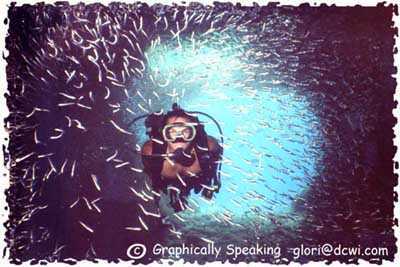
Within the park, The Dolphinarium is a place where you can watch trained dolphins perform. You can even swim with the human-friendly dolphins. To do this, sign up at the Discover Dolphin booth. Or, divers can arrange to dive with the dolphins in the open ocean (sign up at Chankanaab Sports located inside the park).
The park’s botanical garden is home to some 450 native and 350 non-native tropical and sub-tropical plants. For visitors interested in archeology, there is an interactive educational museum. A tour through the small history museum takes only a few minutes and is definitely worth a visit. Scattered throughout are reproductions of Maya ruins and typical living quarters. (If mosquitoes are particularly attracted to you, consider buying insect repellent at one of the park’s shops before you venture on the nature walk into the jungle.)
Chankanaab Nature park is located on the main road, Avenue Rafael Melgar, about five and a half miles or a ten-minute drive south of San Miguel. A taxi costs around 70 pesos (about $7 USD). Admission is about $7 USD, depending on the season.
Note: Because the reef’s ecological system is extremely fragile, park rules forbid you to wear tanning lotion, feed the fish, or touch any of the underwater specimens.
THINGS FOR LAND LOVERS TO DO ON COZUMEL
If by chance, you don´t like in-water sports, don´t worry, there´s something for you too. If you head to the windward side of the island, you’ll find deserted beaches with laid-back beach bars, where sand, sun, volleyball, hammocks, margaritas, and Bob Marley music are the order every day.
Also, there is plenty of shop-till-you-drop in the San Miguel town square, where a multitude of stores will keep any shopper busy for days. You´ll find everything from souvenir items like T-shirts, coffee mugs and blankets to fine art, pottery, and jewelry.
On Sunday one of the really fun cultural events is Fiesta Night. No cruise ships are in port and the friendly locals bring their children, dressed in their Sunday finest, to the main square. Live music is played as local young people walk about, closely eyeing one another, while others young and old are dancing and singing. This is a great chance to join in the normal life of another culture. There are few other places left in the world to enjoy such an evening. Ask anyone who has been there on Sunday night and they will tell you that alone is reason enough to visit this happy island.
Cozumel also dishes up fun after-dark life! Any night of the week, you´re sure to find a party at Carlos ‘N Charlies, Neptuno Disco, Viva Mexico, Scruffie’s Irish Pub or Joe´s Live Reggae Bar, just to name a few.
Or, if you just want to relax and enjoy the more peaceful side of paradise, try a massage and aromatherapy treatment by a licensed, professional massage therapist such as Caribbean Massage!
OTHER SUGGESTIONS
Cozumel is one of the best deep-sea fishing sites in the Caribbean. If you’re looking for a good fight this is what you can get: Sailfish, Tuna, Blue Marlin, Dorado, Barracuda, Woahoo, Maji – maji and large grouper.
View the island and surrounding area from 400´above the water on a para-sailing excursion! Prices run from around $45 to $65. Another fun thing to do is go to the windward side of the island and do some body boarding or surfing, where the waves are just right.
Tour the island on horseback. A 4-hour jaunt can run about $60. This includes transportation to and from the stables, a bilingual guide, and soft drinks or beer, depending on the tour.
The Museo de la Isla de Cozumel is a good place to learn more about the island itself. The museum is housed in what was the first luxury hotel on the island. The well-presented displays feature both pre-hispanic and colonial historic displays as well as ecological, geological and environmental history displays. Admission is around $3.
Visit one of the side street beach bars with reggie music and hammocks to relax in along with a nice cold margarita or cervaza such as the Paradise Reggie Bar near the light house entrance.
WHERE TO EAT
Food and drink in Cozumel are very safe. All drinks are prepared with purified water and the food is fresh. Usually, if you get to feeling funny it’s due to too much sun and not enough water (beer does not qualify as water). Don’t worry, there are plenty of quality pharmacies on the island for just such an emergency. Also, they say Coca Cola is helpful (personlly I prefer fresh fruit drinks.)
Here are a few of my favorite eateries. (Please invite me along!)
BREAKFAST:
Jeannie’s Waffle House on San Miguel the main strip along the ocean. She’s located just below the Vista del Mar Hotel and has another at Days Inn hotel. She’s a family gal that can serve up a great meal! Tell her I said HI!
The Museum of Cozumel also located on the main strip. Great ocean view with excellent food!
Diamond Cafe located at the corner of Streets 3 and 15 is also wonderful for breakfast, lunch or dinner.
LUNCH:
Las Palmas located near the traditional Mexican Market. Just tell the taxi driver, he’ll know. Make sure it’s not confused with the place downtown at the square. This is a local place with excellent food and fresh fruit drinks such as watermelon, melon, jamika (hamika), lemon, orange, papaya and mango. 2 people can eat on about $6 US! I suggest Poc Chuck if you like grilled pork!
Just outside the Traditional Mexican Market, there are several small, good restaurants serving traditional meals. They are located a block from the Red Cross station.
DINNER:
Pepe’s Grill is located on the main strip facing the ocean. This is a 5 star restaurant with VIP service. Live music and great salad bar. Don’t miss out on the Bananas Flambe a dessert to die for. Also the Mayan Coffee is Wonderful.
El Morrito – just ask the taxi driver. It’s VERY good traditional and seafood. Great decor and lots of fun.
El Morro – not to be confused with the one above. Another excellent restaurant. Sea food and traditional Mexican food. Just ask the taxi driver.
Scruffie’s Irish Pub is pretty good with an excellent atmosphere also. They also feature a few Eastern Indian meals. I suggest the Fish n Chips.
Prima – located in the square on the outside. Great Italian and sea food. Excellent crab in season. Very good wine.
Pizza Rohlandi (one of our favorites) – on the main strip just north of town. Gourmet pizza and other excellent dishes.
Los Gavilanies – across from La Mission another good restaurant. But, hey don’t wait in line to go to La Mission. Gavilanies is good and is upstairs with fresh air and GREAT margaritas! Occasionally live music. Excellent price. Watch the margaritas they will catch up to you.
El Morgans – in the main square. A 5 star restaurant. Very romantic and beautiful. Live traditional music and excellent food and service. The ceaser salad is made traditionally and they too have the Maya Coffee and Bananas Flambe.
There are so many others, as you’ll find out, but these will get you started.
For those of you who miss the taste of US food, we do have Dairy Queen here along with a few other franchises.
IF I HAVE A LEGAL PROBLEM, WHO DO I TALK TO?
I doubt if anything will happen, since Cozumel is a safe and friendly place, but like any city sometimes situations occur. If anything should happen, such as you loose your camera or get into an accident with a taxi driver, DO NOT PAY THE TAXI DRIVER DIRECTLY. No matter what he says!
In most situations, you should first contact the Tourist Police (not the regular police). This will take more time but it will be handled appropriately. Most hotels and dive shops also will do their best to help. If you booked through a travel agent, contact them and find out if they have procedures you should follow. If the situation is with your hotel, make sure to talk with the main hotel manager.
HOW TO GET TO COZUMEL
There are direct flights from many points in the United States and Canada to Cozumel. That of course is the easiest way but may cost you more. Continental and American Airlines are the two I know of.
Otherwise, you can fly into the city of Cancun on the mainland and take one of Aerocozumel’s Island Hopper Flights. This is quick and easy, about a 20 minute flight. It’s a handy way to come here just for a day, if you are staying in Cancun. Your travel agent can prearrange your connecting flight, saving you time at the airport, but sometimes this can cost more than buying your ticket at the window. Generally flights leave every 1½ to 2 hours from about 8 a.m. to 8 p.m. Prices vary between $50-$200 US round trip, depending on the season. Telephone from the USA 011-52-(987) 2-08-77, or 2-34-56, or 2-04-68 Fax 011-52-(987) 2-09-28
OR, for the more adventurous, an alternative is to go to Playa Del Carmen by bus or taxi. This is about one hour south of Cancun. From Playa Del Carmen, you can ride the water jet ferry over to Cozumel. This trip takes about 2-3 hours, depending on the connections you make. Here’s how to do it:
Take an airport passenger van to Playa del Carmen or, for a cheaper alternative, take a bus or taxi to the bus terminal in Cancun then take a bus to Playa del Carmen.
TIP: When planning your trip, don’t forget to schedule time for airport customs. This usually takes 15-30 minutes depending on the amount of people.
From the Cancun bus terminal, a bus leaves every 15 to 30 minutes for Playa del Carmen (cost around $ 2.50 US or 25 pesos). From the airport into Cancun city takes around 10 -15 minutes and another 45 minutes to an hour from Cancun to Playa. So, figure on 1½ to 2 hours from Cancun airport to Playa del Carmen. If you land in Cancun any later than 9 pm, you are better off flying or staying in Cancun for your first night (Try Hotel Tankah).
THE FERRY:
The “Mexico Water Jet” takes you from Playa del Carmen to Cozumel island in about 45 min. It is an air conditioned passenger ferry with comfortable seating, music, and videos. Cost around $5 US. The ferries leave as early as 6 a.m. and run about every hour until 9 p.m. For the latest schedule, contact your travel agent or a local dive shop. Remember that Mexico times are central standard and we are on daylight savings time.
TIP: If you miss the last ferry, you’ll be spending the night in Playa del Carmen and there may or may not be rooms available, depending on the season.
Note: There is still some advertising in circulation for a ferry that once ran from Cancun to Cozumel but is no longer operating. Also, many people think that they can rent a car in Cancun and come over on the old car ferry. Not a good idea. The old car ferry is your worst nightmare. This ferry can take up to 3 hours, is dirty, and you have to wait in line with trucks. If there is no room, you don’t get on.
Renting a car once you arrive in Cozumel is easy and affordable. Or, you can reserve a car before you arrive. Some of the rentals are National, Budget and Hertz.

